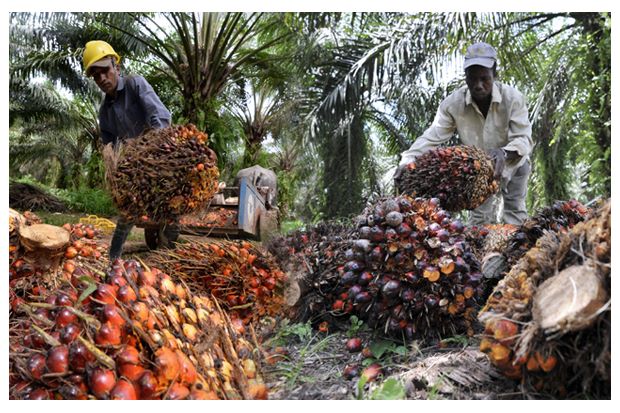Indonesia, Malaysia palm oil output to rise in 2018; may pressure prices
KUALA LUMPUR: Palm oil output in the world’s top two producing countries is forecast to climb to new highs this year as output fully recovers from its El Nino-stunted 2017 level, pushing 2018 average prices down by 7 percent from last year, a Reuters poll showed.
Benchmark prices are forecast to average 2,620 ringgit ($676.30) a tonne this year, versus 2,807 ringgit in 2017, according to the median estimate from a poll of 14 traders, planters and analysts.
Output in top producer Indonesia is forecast to rise to 37.8 million tonnes, while Malaysian output is expected to increase to 20.5 million tonnes, according to the poll.
Palm oil is a commonly used vegetable oil found in everything from soap and chocolate to cooking oil. Nearly 90 percent of global supply is from Indonesia and Malaysia.
Apart from yield recoveries after the 2015 El Nino, a dry weather event which can impact crops for up to two years, production will also rise as more young trees come to maturity, increasing harvested areas.
“We’ve gotten over the effects of the El Nino… 2018 will be a more normalized year for yields, which should increase from last year, as (earlier) replanting will take out some of the lower yielding areas,” said an Indonesian planter.
Another Indonesian planter added that ample rainfall since last year should aid production in the second half of 2018.
Production is likely to slow from the start of the year until March, before peaking in the third quarter, in line with seasonal trends.
“Year-on-year, growth will be strong in Q1, in the range of double digit growth, but will normalize to single digit growth in Q2 and the second half of the year,” said Alan Lim, plantations analyst at MIDF Research.
The Malaysian Palm Oil Board reported 2017 output at 19.9 million tonnes, while the Indonesia Palm Oil Association estimated production last year at 36.5 million tonnes.
DEMAND TO DRIVE PRICES
While rising output could pressure prices, palm may face competition from large crops of other edible oils this year.
“Global soft oil supplies are expected to be record high, on the back of large soybean, rapeseed and sunflower seed crops across major producing regions… (which) will provide competition for palm oil demand and curb potential price rallies,” said a Rabobank report, adding demand growth in palm’s two biggest importers, China and India, could be limited.
India’s palm oil import growth potential will be capped by the availability of competing rival oils, while China is expected to import a record amount of soybeans to crush for feed to sustain its meat production, boosting the supply of soyoil for the domestic market.
Recent gains in crude oil prices, however, could spur demand for palm oil from biodiesel producers, which would contribute to the 4 to 5 percent increase in global palm oil demand predicted by the poll respondents.
Oil prices have risen over 40 percent since mid-2017, making biodiesel more competitive as a fuel replacement. Palm oil is used as a feedstock to make biodiesel.
Indonesia is aiming to expand biodiesel subsidies to cover consumption of palm oil-blended fuels by the mining sector this year. The subsidy for its programme with a minimum 20 percent bio content was previously only available to the power sector.
Malaysia’s biodiesel mandate requires a minimum biofuel content of 7 percent for its transportation sector. ($1 = 3.8740 ringgit) – Reuters
Source: https://www.thestar.com.my/business/business-news/2018/01/29/indonesia-malaysia-palm-oil-output-to-rise-in-2018/#DGZb7vKkYyo8FZXi.99


 Thailand
Thailand




